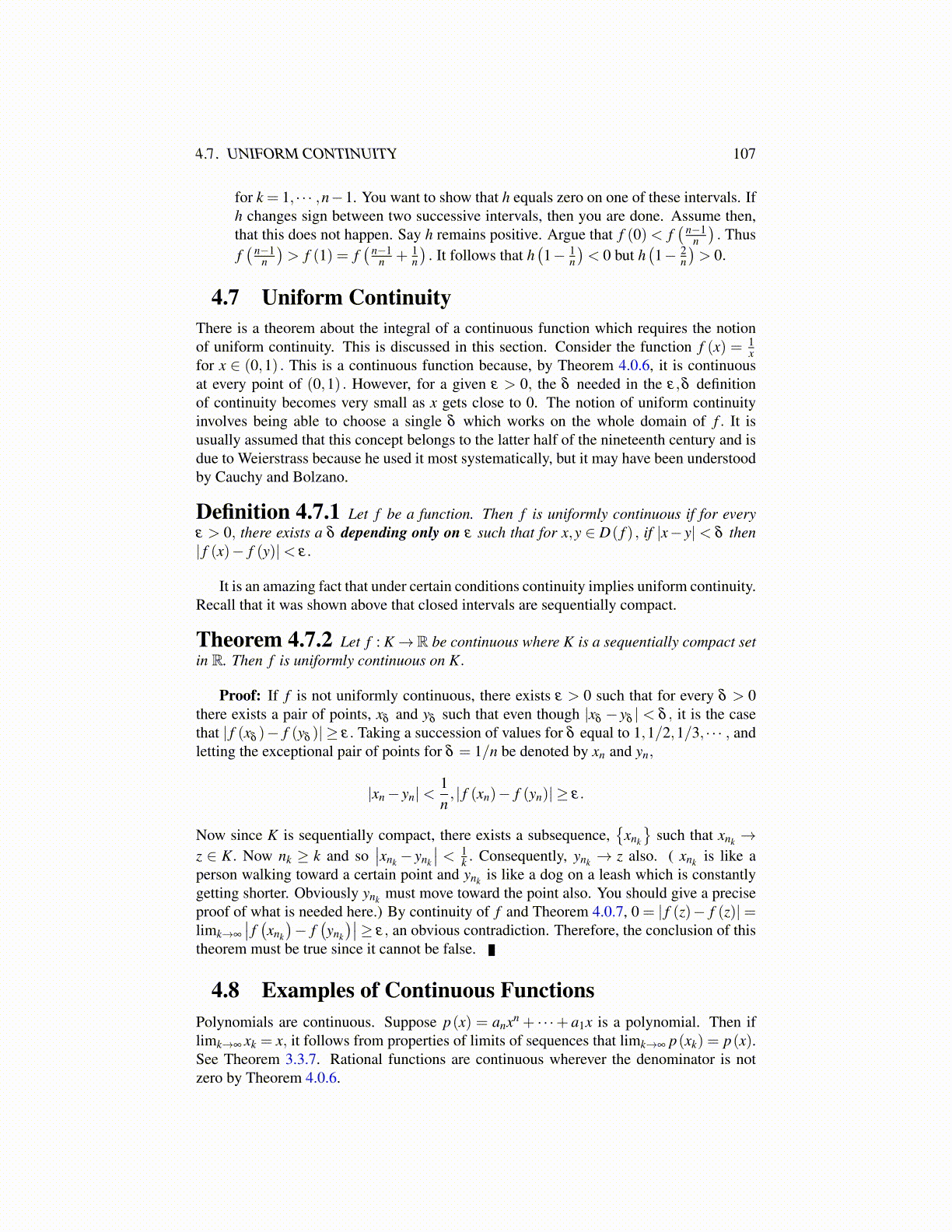
4.7. UNIFORM CONTINUITY 107
for k = 1, · · · ,n−1. You want to show that h equals zero on one of these intervals. Ifh changes sign between two successive intervals, then you are done. Assume then,that this does not happen. Say h remains positive. Argue that f (0)< f
( n−1n
). Thus
f( n−1
n
)> f (1) = f
( n−1n + 1
n
). It follows that h
(1− 1
n
)< 0 but h
(1− 2
n
)> 0.
4.7 Uniform ContinuityThere is a theorem about the integral of a continuous function which requires the notionof uniform continuity. This is discussed in this section. Consider the function f (x) = 1
xfor x ∈ (0,1) . This is a continuous function because, by Theorem 4.0.6, it is continuousat every point of (0,1) . However, for a given ε > 0, the δ needed in the ε,δ definitionof continuity becomes very small as x gets close to 0. The notion of uniform continuityinvolves being able to choose a single δ which works on the whole domain of f . It isusually assumed that this concept belongs to the latter half of the nineteenth century and isdue to Weierstrass because he used it most systematically, but it may have been understoodby Cauchy and Bolzano.
Definition 4.7.1 Let f be a function. Then f is uniformly continuous if for everyε > 0, there exists a δ depending only on ε such that for x,y ∈ D( f ) , if |x− y| < δ then| f (x)− f (y)|< ε.
It is an amazing fact that under certain conditions continuity implies uniform continuity.Recall that it was shown above that closed intervals are sequentially compact.
Theorem 4.7.2 Let f : K →R be continuous where K is a sequentially compact setin R. Then f is uniformly continuous on K.
Proof: If f is not uniformly continuous, there exists ε > 0 such that for every δ > 0there exists a pair of points, xδ and yδ such that even though |xδ − yδ | < δ , it is the casethat | f (xδ )− f (yδ )| ≥ ε. Taking a succession of values for δ equal to 1,1/2,1/3, · · · , andletting the exceptional pair of points for δ = 1/n be denoted by xn and yn,
|xn − yn|<1n, | f (xn)− f (yn)| ≥ ε.
Now since K is sequentially compact, there exists a subsequence,{
xnk
}such that xnk →
z ∈ K. Now nk ≥ k and so∣∣xnk − ynk
∣∣ < 1k . Consequently, ynk → z also. ( xnk is like a
person walking toward a certain point and ynk is like a dog on a leash which is constantlygetting shorter. Obviously ynk must move toward the point also. You should give a preciseproof of what is needed here.) By continuity of f and Theorem 4.0.7, 0 = | f (z)− f (z)|=limk→∞
∣∣ f (xnk
)− f
(ynk
)∣∣≥ ε, an obvious contradiction. Therefore, the conclusion of thistheorem must be true since it cannot be false.
4.8 Examples of Continuous FunctionsPolynomials are continuous. Suppose p(x) = anxn + · · ·+ a1x is a polynomial. Then iflimk→∞ xk = x, it follows from properties of limits of sequences that limk→∞ p(xk) = p(x).See Theorem 3.3.7. Rational functions are continuous wherever the denominator is notzero by Theorem 4.0.6.